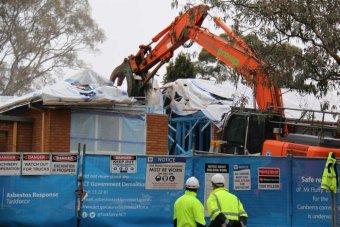A new study into health risks linked to Mr Fluffy loose-fill asbestos-contaminated houses has found a rising incidence of mesothelioma in Canberra over the past 30 years.
But the Australian National University research found in the period from 1982 to 2011, only one case of mesothelioma had been diagnosed in a person while living in a Mr Fluffy house.
The potentially deadly asbestos fibres have led to a buyback and demolition scheme for more than 1,000 affected houses in Canberra.
The study found the rate of mesothelioma cases in the ACT between 1994 and 2011 rose at a slightly greater rate than the rest of Australia.
However the study’s co-lead investigator Rosmary Korda said finding trends from the data carried statistical uncertainty because of the small case numbers involved.
“Mesothelioma is a relatively rare cancer so we know there has only been about 140 cases in the last 30 years,” she said.
“There has been an increase in rates, but we don’t know if it is connected with Mr Fluffy.
“This study is a descriptive study, we look at all the cases over time that have been registered in the ACT, but it just describes the trends and we compare them to other jurisdictions.”
This rise in rates means the ACT now has a similar diagnosis rate to the rest of Australia.
“Although rates have been rising in the ACT, they have been lower on average than the rates for rest of Australia,” Ms Korda said.
“However, in recent years ACT rates appear to have caught up with the rest of Australia.”
Inhalation of asbestos fibres is the predominant cause of mesothelioma and an important contributor to risk of lung cancer in exposed people.
Mesothelioma symptoms can take 20 to 50 years to appear after the initial exposure.
The study also found that men were more likely to be diagnosed with mesothelioma, with four out of every five cases diagnosed in men.
Also, a large portion of the cases were diagnosed in people aged 65 and older, with less than 5 percent diagnosed in people aged under 45.
Health minister Simon Corbell said the study is the first of four reports into the health risks of living in a house with loose-fill asbestos.
The four parts of the study are:
1. An analysis of mesothelioma rates and distribution in the ACT;
2. Focus groups held with current and recent residents of affected houses to discuss their health-related concerns with voluntary participation;
3. The likely exposure levels and health-related concerns of current and recent residents in terms of years lived in an affected house and activities such as renovating; and
4. Linking the data sets to estimate the risk of developing mesothelioma in current and former residents of affected houses compared with the general population.
“This report is only the first part of the study. Each part of the study will feed information into the next, so the whole picture will not become clear until the end of the study,” he said.
The final results of the study will be released in 2017.

